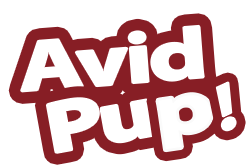
Sodium can be a rather controversial mineral in both human food and canine food. For us humans, sodium is one of those things that you need to eat in moderation, despite all of the great taste it brings to dishes.
While we know to avoid excessive sodium levels in our food, how does a dog’s body handle the mineral?
A dog’s body reacts differently to foods than ours do. However, that doesn’t mean that they can eat whatever they want. Your dog needs sodium to stay healthy.
It’s responsible for regulating blood pressure, maintains the pH levels in their body, and even plays a role in nerve impulses. Though, too much of it can be detrimental.
It’s a fine line between providing your dog with too much sodium and too little.
Generally speaking, there’s no need to worry too much about sodium levels in healthy dogs. It’s when dogs get a bit older or when they’re suffering from health issues that you need to consider making the switch to a low-sodium diet.
There are many great low-sodium foods on the market.
Before you start the transition, consult with your veterinarian for more guidance. They’ll be able to push you in the right direction and help you figure out your dog’s exact needs.
Once you get the go-ahead, here are some of the best foods that can benefit your dog’s health.
5 of the Best Low-Sodium Foods for Dogs
1. The Honest Kitchen Whole Grain Beef Dog Food Recipe
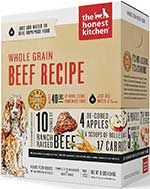
If you’re looking for the very best for your dog, why not go with something that’s organic, all-natural, and human-grade?
This dehydrated food from the Honest Kitchen contains high-quality ingredients that meet the strict FDA standards for human foods. Instead of the traditional baking process, the food is dehydrated.
All you have to do is add some warm water to bring it back to life and serve your dog a fresh meal. It’s soft, delicious, and very healthy.
There are no GMOs, byproducts, or unnecessary additives.
2. Orijen Original Dry Dog Food

This food from Orijen is formulated to meet the biological needs of canines. So, it’s chock-full of protein and healthy ingredients.
Deboned chicken, deboned turkey, and selection of fish are used as the main protein source. There are also organs like livers and hearts. When it comes to sodium, the food has about 76 mg per 100 calories.
As a result, it’s great for pups who are on a moderate sodium restriction. What you won’t find is grains, unnecessary filler, or artificial additives.
3. Hill’s Prescription Diet h/d Cardiac Health Dry Dog Food
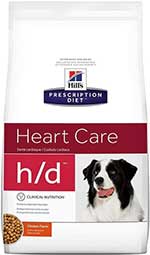
Hill’s Science is a popular brand among vets due to their specially formulated products.
The Cardiac Health recipe is ideal for dogs that need a diet that’s very low in sodium.
The kibble is made up of only 0.08 percent sodium. It helps to regulate blood pressure levels while also supporting overall heart health. Ingredients like taurine and L-Carnitine can maintain good heart function.
Plenty of vitamins are added as well. This helps to ensure that your dog’s body has all it needs, even if they lose vitamins through medications and increased urination.
4. ROYAL CANIN Canine Early Cardiac Dry

Another dog food that’s made with heart health in mind is this kibble from Royal Canin.
It has about 0.33 percent sodium, making it a great option for dogs with moderate restrictions.
The food can help to manage heart disease and hypertension through its use of quality ingredients. Chicken and fish meal are the primary source of protein. There’s also omega fatty acids to support the heart even further.
You won’t find any potentially dangerous ingredients, such as MSG or artificial preservatives.
5. Earthborn Holistic Adult Vantage Natural Dry Dog Food
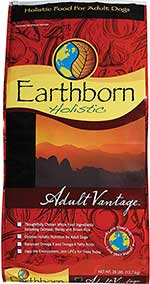
The Adult Vantage formula from Earthborn Holistic is a great all-purpose food that can keep your dog healthy throughout their life.
It has great ingredients like chicken meal, sweet potato, and fish meal. There are also antioxidant-rich fruits like cranberries and blueberries as well as omega fatty acids.
The sodium content is quite low.
There’s about 60 mg of sodium per 100 calories of food. As a result, it’s great for managing hypertension. Overall, the kibble is balanced and healthy.
Low-Sodium Canned Food Options
1. EVO 95-Percent Chicken & Turkey Dog Food

This canned food from EVO is a high-protein dog food that has very low sodium levels. It has great ingredients like chicken, turkey, chicken liver, and more.
There are no grains. Instead, the recipe contains healthy doses of vitamins and minerals. The sodium content is approximately 0.11 percent. There isn’t any added MSG or salt.
The food also lacks the high-sodium broth that’s often used in canned products. It’s a safe and delicious meal that can keep your dog’s blood pressure in check.
2. Zignature Whitefish Low Sodium, High Protein Grain Free Wet Dog Food Cans
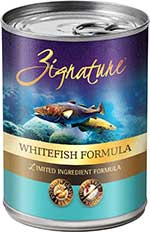
From Zignature is this unique canned food. It’s a limited ingredient formula that utilizes whitefish as its main source of protein.
This is an excellent choice for dogs with sodium restrictions, as whitefish is naturally low in sodium. However, it’s high in all the good stuff, like omega fatty acids and vitamins.
Overall, the recipe has only 0.11 percent sodium in it. Beneficial ingredients like peas, flaxseed, carrots, and blueberries are included as well to support your dog’s entire body.
How Much Sodium Do Dogs Need?
If your dog is healthy, their body goes to great lengths to regulate sodium levels. As previously mentioned, dogs need a certain amount of sodium to thrive.
If they eat a bit more than they really need, dogs have ways to balance things out. They can get rid of extra sodium through urination and more water intake.

While they can self-regulate, that doesn’t mean you should just ignore sodium levels in your pup’s food completely.
Unfortunately, there’s no exact information about sodium levels out there. All dogs are different.
Everything from breed to weight and lifestyle could affect how much sodium your pup needs to stay healthy.
To make matters even more confusing, most manufacturers don’t even print sodium levels on their packaging! It’s not required by law, so many brands don’t even bother to provide that information.
If you want to get exact levels, you may need to contact the company directly for some more in-depth information.
The Association for American Feed Control Officials, or AAFCO, is responsible for setting guidelines on the nutritional content of dog food.
Unfortunately, they don’t have established guidelines for sodium content either. However, veterinarians have developed a system for recommending dietary changes.
Typically, the following guidelines are used to help owners get a better idea of what their pup needs based on their health restrictions.
- Healthy dogs with no sodium restrictions – 0.5 percent of their diet or approximately 100 mg per 100 calories of food
- Mild sodium restrictions – 0.33-0.5 percent of diet or 80-100 mg per 100 calories of food
- Moderate sodium restrictions – 0.1-0.3 percent of diet or 50-80 mg per 100 calories of food
- Severe sodium restrictions – less than 0.1 percent of diet or fewer than 50 mg per 100 calories of food.
When You Should Consider a Low-Sodium Diet
If a vet recommends that you provide your dog with a low-sodium diet, there’s probably a good reason for it.
Most often, sodium restrictions are placed on dogs that suffer from a number of different ailments.
Sodium can agitate a handful of diseases. Switching to low-sodium food can help prevent the problem from worsening or help your dog avoid uncomfortable symptoms.
Heart Problems
Contrary to popular belief, dogs don’t usually develop hypertension from their diets. Unless that is, you feed them salty human foods on a regular basis.
Normal commercially available foods don’t have nearly as much sodium to make that an issue.
More often than not, high blood pressure is a result of genetics, a sedentary lifestyle, and other medical conditions. If that’s the case, your vet will probably recommend low-sodium food to prevent secondary problems from hypertension from occurring.
One of the biggest is congestive heart failure. This happens when the heart is unable to pump blood throughout the body as well as it should.
Your dog’s body is having a harder time processing those sodium ions. It’s a potentially fatal issue that often follows hypertension.
Organ Failure
Dogs with liver or kidney disease are also put on low-sodium diets. Sodium is filtered out of the body through these organs.
When they’re not functioning properly, your dog will experience a significant spike in sodium levels in the blood.
Excess sodium also puts unnecessary stress on these organs, so a low-sodium diet is preferred.
Hypernatremia
This is one of the most common reasons why low-sodium foods are recommended. When dogs suffer from Hypernatremia, they lose a lot of water in their gastrointestinal tract. This leads to a host of issues.
Symptoms include higher thirst levels, lethargy, more frequent urination, diarrhea, vomiting, and more.
The loss of water can also increase your dog’s risks of heart disease, as it results in higher blood pressure than normal.
If you notice any symptoms of Hypernatremia, it’s important that you bring your dog to a vet as soon as possible for diagnosis and treatment.
The Benefits of Low-Sodium Dog Food
Just because your dog doesn’t suffer from one of the previous diseases doesn’t mean that they can’t benefit from a low-sodium diet.
Low-sodium foods have their advantages for even healthy dogs. As always, speak with your vet beforehand to make sure that your four-legged friend can handle the change.
Regulating Blood Pressure
If you know that your dog is susceptible to high blood pressure, you can use low-sodium foods to avoid the problem from occurring.
Many breeds, such as Dachshunds, Poodles, and Schnauzers, are more genetically predisposed to hypertension than others.

Also, overweight dogs have a higher risk of developing heart issues.
A low-sodium diet can help you be proactive about hypertension. If your dog already suffers from it, you can use the food to keep their blood pressure in check.
Better Hydration
Does your dog make frequent trips to the water bowl? While drinking a lot of water is great for your pup’s overall health, drinking too much water may be a sign that they’re a bit dehydrated.
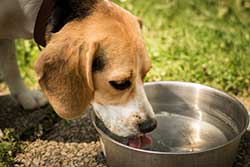
Salty foods are known to make any living creature thirsty. That’s because sodium binds to water, making it unavailable for other parts of the body.
Drinking a ton of water each day can result in some health complications. For one, their gastrointestinal tract could get all out of whack.
A sudden influx of water can cause runny stool and discomfort. Also, the frequent trips outside to urinate can put a lot of undue stress on the kidneys and livers.
By cutting back on sodium, your dog can stay hydrated throughout the day without needing to take a drink every few minutes.
Senior Canine Health
As dogs get older, they have a greater risk of suffering from heart conditions, weight problems, and high blood pressure.
It’s important that you modify your pup’s diet once they reach their senior years and start to live a more relaxed life.
A low-sodium diet may be recommended by your vet to help stave off common health conditions.
How to Choose the Right Low-Sodium Formula
Finding a low-sodium dog food for your pup is all about providing them with a balanced diet that’s nutritious and delicious.
Obviously, it’s important that you do some research about a particular food’s sodium content.
Beyond that, you also need to make sure that it has all the macronutrients your pup needs to stay happy and healthy.
Good Sources of Protein
Protein should always be at the top of any ingredient’s list. It’s the single most important nutrient your dog needs. Look out for wholesome sources that are easily identifiable.
Things like beef, deboned chicken, fish, and bison are all great. A high percentage of protein is also recommended to keep your pooch’s muscles in tip-top shape.
Slow-Burning Carbs
Fillers like corn, wheat, and soy are often used in cheaper foods like carbohydrates. They should be avoided.
Those simple carbs are absorbed pretty quickly, leading to blood sugar problems.
Slow-burning carbs, such as sweet potatoes and peas are much better.
The complex carbs break down throughout the day, providing a steady stream of energy.
Calorie Content
In most cases, dogs that suffer from sodium-related health problems experience weight gain. To ensure that your pup doesn’t balloon in size, you may want to consider a weight management formula.
These foods offer high-quality protein sources with less fat and sodium.
Vitamins and Minerals
Of course, a healthy dose of vitamins and minerals are always good. Go with foods that are filled with leafy greens and healthy fruits.
Plenty of vitamins and minerals can keep your dog’s organs in good shape.
Some ingredients contain beneficial extras like antioxidants and omega fatty acids, which could help support circulatory health.
Should You Go With Wet or Dry Food?
Low sodium foods are available in standard dry kibble and canned wet food. The right option for your dog comes down to personal preference and lifestyle.
If your dog is otherwise healthy and has no problem chewing food, go with kibble. It’s more affordable and can help to improve dental health.
However, if your dog is a bit older, they can benefit from canned food. Canned food is soft, easy to chew, and has a much higher moisture content.
The added moisture from the food can add a boost of hydration, which is great if you’re trying to regulate sodium levels.
Just make sure that the canned food has a low-sodium broth or gravy.
Things to Avoid
When you’re perusing an ingredient’s list, look out for the following additives. They are not good for dogs that need a low-sodium diet, as they can increase the overall sodium content of the food.
Additional Salt or MSG
You should avoid any salt or MSG as much as possible. MSG is a common ingredient that’s used in processed foods and dog treats.
Even a little bit of the stuff will increase the overall sodium levels of food, so it’s important that you avoid it as much as possible.
Nitrates
Nitrates are another ingredient that’s high in sodium. It’s a preservative that’s found in many cured meat and dog treats.
Despite the flavor it adds, the ingredient is not healthy for dogs that are on a restricted diet.
Conclusion
Low-sodium dog foods provide wonderful benefits to all dogs. To those that suffer from health issues, these foods can do a lot to keep them happy, healthy, and comfortable.
Whether your dog suffers from an ailment or you’re simply looking to avoid issues in the future, consult with your vet and give these foods a try.
Also Read: The Reason Why Your Pup is Always Hungry

